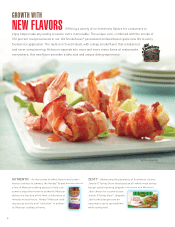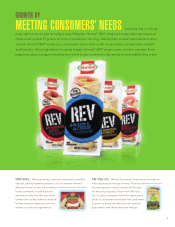Hormel Foods 2013 Annual Report Download - page 17
Download and view the complete annual report
Please find page 17 of the 2013 Hormel Foods annual report below. You can navigate through the pages in the report by either clicking on the pages listed below, or by using the keyword search tool below to find specific information within the annual report.15
The estimates and assumptions used consider historical
performance and are consistent with the assumptions used
in determining future profit plans for each reporting unit,
which are approved by the Company’s Board of Directors.
The Company reviews product growth patterns, market share
information, industry trends, peer group statistics, changes in
distribution channels, and economic indicators in determining
the estimates and assumptions used to develop cash flow and
profit plan assumptions. Additionally, the Company performs
sensitivity testing of the profit plan assumptions and discount
rate to assess the impact on the fair value for each reporting
unit under various circumstances.
If the first step results in the carrying value exceeding the
fair value of any reporting unit, then a second step must be
completed in order to determine the amount of goodwill
impairment that should be recorded. In the second step, the
implied fair value of the reporting unit’s goodwill is deter-
mined by allocating the reporting unit’s fair value to all of its
assets and liabilities other than goodwill in a manner similar
to a purchase price allocation. The implied fair value of the
goodwill that results from the application of this second step is
then compared to the carrying amount of the goodwill and an
impairment charge is recorded for the difference. Even if not
required, the Company periodically elects to perform the quan-
titative test in order to confirm the qualitative assessment.
Based on the qualitative assessment conducted in fiscal
2013, performance of the quantitative two-step test was not
required for any of the Company’s reporting units. However,
the Company also elected to perform the quantitative test in
fiscal 2013 to further validate the qualitative assessment. No
goodwill impairment charges were recorded.
In conducting the annual impairment test for its indefi-
nite-lived intangible assets, the Company first performs a
qualitative assessment to determine whether it is more likely
than not (> 50% likelihood) that an indefinite-lived intangible
asset is impaired. If the Company concludes that this is the
case, then a quantitative test for impairment must still be
performed. Otherwise, the Company does not need to perform
a quantitative test.
In conducting the initial qualitative assessment, the Company
analyzes growth rates for historical net sales and the results
of prior quantitative tests performed. Additionally, each
reporting unit assesses critical areas that may impact their
intangible assets or the applicable royalty rates to determine
if there are factors that could impair the asset.
If performed, the quantitative impairment test compares the
fair value and carrying value of the indefinite-lived intangible
asset. The fair value of indefinite-lived intangible assets is pri-
marily determined on the basis of estimated discounted value,
using the relief from royalty method. The assumptions used
in the estimate of fair value, including future sales projections
these raw materials using a concept referred to as the “meat
cost pool.” The meat cost pool is determined by combining the
cost to grow turkeys with processing costs, less any net sales
revenue from by-products created from the processing and
not used in producing Company products. The Company has
developed a series of ratios using historical data and current
market conditions (which themselves involve estimates and
judgment determinations by the Company) to allocate the
meat cost pool to each meat component. Substantially all
inventoriable expenses, meat, packaging, and supplies are
valued by the average cost method.
Goodwill and Other Intangibles: The Company’s identifiable
intangible assets are amortized over their useful lives, unless
the useful life is determined to be indefinite. The useful life of
an identifiable intangible asset is based on an analysis of sev-
eral factors including: contractual, regulatory, or legal obliga-
tions, demand, competition, and industry trends. Goodwill and
indefinite-lived intangible assets are not amortized, but are
tested at least annually for impairment.
The Company’s goodwill impairment test is performed at the
reporting unit level. The Company’s reporting units represent
operating segments (aggregations of business units that have
similar economic characteristics and share the same produc-
tion facilities, raw materials, and labor force). In conducting
the goodwill impairment test, the Company first performs a
qualitative assessment to determine whether it is more likely
than not (> 50% likelihood) that the fair value of any reporting
unit is less than its carrying amount. If the Company concludes
that this is the case, then a two-step quantitative test for good-
will impairment is performed for the appropriate reporting
units. Otherwise, the Company concludes that no impairment
is indicated and does not perform the two-step test.
In conducting the initial qualitative assessment, the Company
analyzes actual and projected growth trends for net sales,
gross margin, and segment profit for each reporting unit, as
well as historical performance versus plan and the results of
prior quantitative tests performed. Additionally, each report-
ing unit assesses critical areas that may impact its business,
including macroeconomic conditions and the related impact,
market related exposures, any plans to market all or a portion
of their business, competitive changes, new or discontin-
ued product lines, changes in key personnel, or any other
potential risks to their projected financial results. All of the
assumptions used in the qualitative assessment require sig-
nificant judgment.
If performed, the quantitative goodwill impairment test is a
two-step process. First, the fair value of each reporting unit is
compared to its corresponding carrying value, including good-
will. The fair value of each reporting unit is estimated using
discounted cash flow valuations. The assumptions used in the
estimate of fair value, including future growth rates, terminal
values, and discount rates, require significant judgment.
























